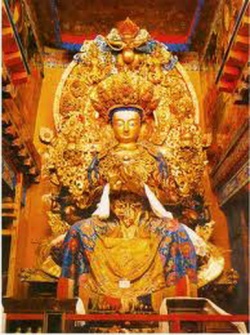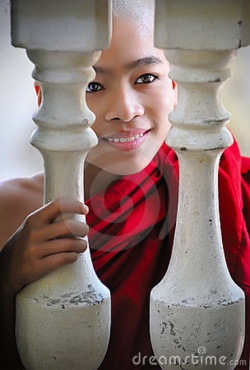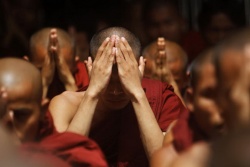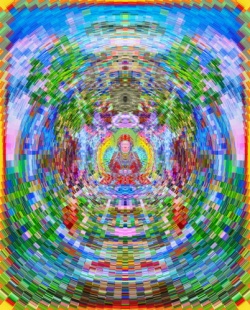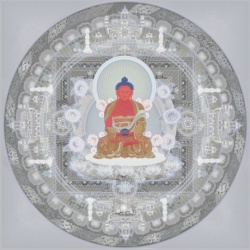Bon: a heterodox system
Tibetans commonly draw a distinction between three religious traditions:
(1) the divine dharma (Iha chos), or Buddhism;
(2) Bon dharma (bon chos); and
(3) the dharma of human beings (mi chos), or folk religion.
The first category includes doctrines and practices that are thought to be distinctively Buddhist. This classification implicitly assumes that the divine dharma is separate and distinct from the other two, although Tibetan Buddhism clearly incorporated elements of both of these traditions.
Bon is commonly considered to be the indigenous religious tradition of Tibet, a system of shamanistic and animistic practices performed by priests called shen (gshen) or bonpo (bon po). Although this is widely assumed by Buddhists, historical evidence indicates that the Bon tradition only developed as a self-conscious religious system under the influence of Buddhism.
When Buddhism entered the country practitioners of indigenous traditions recognized that there were clear differences between their own practices and those of the foreign faith, and in time people who perceived themselves as adherents of the old religion of Tibet developed a separate tradition, but one that incorporated many Buddhist elements. Although later historical works state that the introduction of Buddhism was initially opposed by "Bon," this term is not even used in the early dynastic records to refer to indigenous traditions and practices. Instead, they are called cho (chos), the same term later used to translate the Sinskrit term dharma, which in Buddhist literature refers to Buddhist doctrine and practice. In inscriptions on the tomb of king Senalek (799-815), for example, the term bon refers to the royal priests whose job was to perform rituals for the Yarlung kings.
In early, records, "bon" denotes a particular type of priest who performed rituals to propitiate local spirits and ensure the well-being of the dead in the afterlife. It is only much later, under the influence of Buddhism, that "Bon" comes to designate pre-Buddhist Tibetan religious practices in general. It should also be noted that the rituals performed by these early priests as reported in the old records appear to differ substantially from contemporary Bon. As Per Kvaerne notes, for example, they were by all accounts concerned with taking care of the dead through ceremonies intended to ensure their safe journey to the afterlife and their material prosperity after arrival.1 The rituals of the bon often involved sacrificing animals (mainly horses, yaks, and sheep), making offerings of food and drink, and burying the dead with precious jewels, the benefits of which were apparently transferred to them in the afterlife through shamanistic rituals. The most elaborate of these were the ceremonies for the kings, each of whom was buried in a specially-constructed tomb, and apparently joined in death by servants, ministers, and retainers. The royal priests then performed special ceremonies, which according to old records sometimes lasted for several years. These were intended to ensure the well-being of the kings in the afterlife and to solicit their help in mundane affairs.
Animism in Tibetan Folk Religion The Tibetan folk religion encompasses indigenous beliefs and practices, many of which predate the introduction of Buddhism and which are commonly viewed as being distinct from the mainstream of Buddhist practice. These are primarily concerned with propitiation of the spirits and demons of Tibet, which are believed to inhabit all areas of the country Folk religious practices rely heavily on magic and ritual and are generally intended to bring mundane benefits, such as protection from harm, good crops, healthy livestock, health, wealth, etc. Their importance to ordinary people should not be underestimated, since in the consciousness of most Tibetans the world is full of multitudes of powers and spirits, and the welfare of humans requires that they be propitiated and sometimes subdued. Every part of the natural environment is believed to be alive with various types of sentient forces, who live in mountains, trees, rivers and likes, rocks, fields, the sky, and the earth. Every region has its own native supernatural beings, and people living in these areas are strongly aware of their presence. In order to stay in their good graces, Tibetans give them offerings, perform rituals to propitiate them, and sometimes refrain from going to particular places so as to avoid the more dangerous forces.
In the often harsh environment of Tibet, such practices are believed to give people a measure of control over their unpredictable and sometimes hazardous surroundings. With the almost total triumph of Buddhism in Tibet, the folk religion became infused with Buddhist elements and practices, but it still remains distinct in the minds of the people, mainly because its focus is on pragmatic mundane benefits, and not on final liberation or the benefit of others. By all accounts, Tibetans have always been fascinated by magical and occult practices, and from the earliest times have viewed their country as the abode of countless supernatural forces whose actions have direct bearing on their lives. Since Buddhist teachers tend to focus on supramundane goals, Tibetans naturally seek the services of local shamans, whose function is to make contact with spirits, to predict their influences on people's lives, and to perform rituals that either overcome harmful influences or enlist their help.
When Buddhism entered Tibet, it did not attempt to suppress belief in the indigenous forces. Rather, it incorporated them into its worldview, making them protectors of the dharma who were converted by tantric adepts like Padmasambhava, and who now watch over Buddhism and fight against its enemies. An example is Tangla, a god associated with the Tangla mountains, who was convinced to become a Buddhist by Padmasambhava and now is thought to guard his area against forces inimical to the dharma. The most powerful deities are often considered to be manifestations of buddhas, bodhisattvas, Oikinis, etc., but the mundane forces are thought to be merely worldly powers, who have demonic natures that have been suppressed by Buddhism. Although their conversion has ameliorated the worst of their fierceness, they are still demons who must be kept in check by shamanistic rituals and the efforts of Buddhist adepts. Nor should it be thought that Buddhist practitioners are free from the influences of the folk religion. These beliefs and practices are prevalent in all levels of Tibetan society, and it is common to see learned scholar-lamas, masters of empirically-based dialectics and thoroughly practical in daily affairs, refuse to travel at certain times in order to avoid dangerous spirits or decide their travel schedules after first performingl divination to determine the most auspicious time. Such attitudes may be dismissed as "irrational" by Westerners, but for Tibetans they are entirely pragmatic responses to a world populated by forces that are potentially harmful.
Types of Spirits
According to folk beliefs, the world has three parts: sky and heavens, earth, and the "lower regions." Each of these has its own distinctive spirits, many of which influence the world of humans. The upper gods (steng Iha) live in the atmosphere and sky, the middle tsen (bar btsan) inhabit the earth, and the lower regions are the home of yoklu (g.yog klu), most notably snake-bodied beings called lu (klu naga), which live at the bottoms of lakes, rivers, and wells and are reported to hoard vast stores of treasure. The spirits that reside in rocks and trees are called nyen (gnyan); they are often malicious, and Tibetans associate them with sickness and death. Lu are believed to bring leprosy, and so it is important to keep them away from human habitations. Sadak (sa bdag, "lords of the earth") are beings that live under the ground and are connected with agriculture. Tsen are spirits that live in the atmosphere, and are believed to shoot arrows at humans who disturb them. These cause illness and death. Tsen appear as demonic figures with red skin, wearing helmets and riding over the mountains in red horses. Du (bdud, mara) were apparently originally atmospheric spirits, but they came to be associated with the Buddhist demons called mara which are led by their king (also named Mara), whose primary goal is to lead sentient beings into ignorance, thus perpetuating the vicious cycle of samsara.
There are many other types of demons and spirits, and a comprehensive listing and discussion of them exceeds the focus of this book. Because of the great interest most Tibetans have in these beings and the widespread belief in the importance of being aware of their powers and remaining in their good graces, the folk religion is a rich and varied system, with a large pantheon, elaborate rituals and ceremonies, local shamans with special powers who can propitiate and exorcise, and divinatory practices that allow humans to predict the influences of the spirit world and take appropriate measures. All of these are now infused with Buddhist influences and ideas, but undoubtedly retain elements of the pre-Buddhist culture.
BON TEACHINGS AND PRACTICES
Adherents of Bon view their tradition as being distinct from Buddhism, although it clearly contains many Buddhist elements. The term bon for Bonpos (practitioners of Bon) signifies "truth," "reality," and "the true doctrine" which provides a path to liberation. For Bonpos, bon has roughly the same range of meanings that the term cho(chos, dharma) has for Tibetan Buddhists: it refers to their religion as a whole-teachings, practices etc.-which are believed to have been revealed by enlightened beings who took rebirth in order to lead others to salvation. Bon today has absorbed many Buddhist elements, and many of its teachings are strikingly similar to those of Tibetan Buddhism. David Snellgrove contends that it has incorporated so many Buddhist elements that it has become
a form of Buddhism that may fairly be regarded as heretical, in that those who follow it have persisted in claiming that their religion was taught not by Sakyamuni Buddha, but by Shen-rab Shenrap, likewise accepted as Buddha, and that it came not from India, but from Ta-zig Taksik and by way of Zhang-zhung Shangshung. Such are the Bonpos, who have managed to hold their own down to the present day against the enormously more powerful representatives of orthodox Buddhism, while they are constantly and quite wrongly identified by other Tibetans ... as the persistent practitioners of pre-Buddhist Tibetan religion.2
In Buddhist sources, the Bonpos are commonly portrayed as malicious reactionaries whose manipulations hindered the dissemination of the dharma, who caused Santaraksita to be driven from the country, and who tried to prevent Padmasambhava's arrival. As Snellgrove and Richardson contend, however, such characterizations are probably unfair to Bon and are written from a rather narrow perspective.
Like all national historians, Tibetan writers of history see everything from a Tibetan point of view, and being fervent Buddhists as well, they inevitably see everything from a rather special Tibetan Buddhist point of view. Their view of the world around them is a simple one: in so far as it furthers the interests of their religion in general and their own religious order and monastery in particular, it is good; in so far as it works against their religion, their order and their monastery it is evil. Intemally the Bon-pos tend to become the scapegoat for everything that had rendered the Buddhist conversion of Tibet at all difficult, while most Tibetan Buddhists themselves remain almost innocently unaware of the great variety of pre-Buddhist beliefs and practices that they have absorbed as an accepted part of their daily thoughts and actions .
